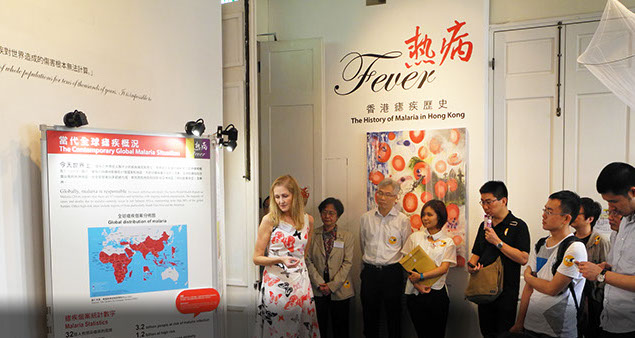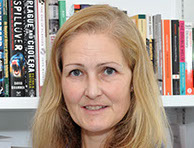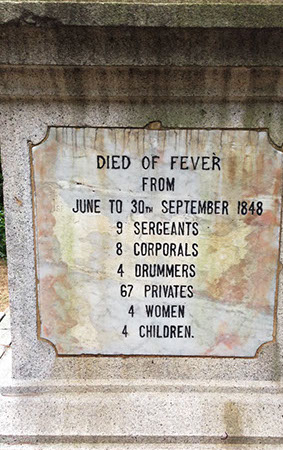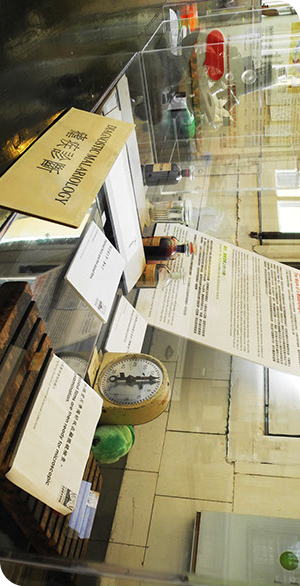
Fever: The History of Malaria in Hong Kong will run at the Hong Kong Museum of Medical Sciences till July 26.

Hong Kong’s
Malaria-Ridden Past
SARS and bird flu put Hong Kong on the global health map in recent times, but not so long ago the city was a hotbed of another, much more common scourge: malaria. A new exhibition tells the story.
Dr Ria Sinha, who is a Post-doctoral Fellow in the Centre for the Humanities and Medicine (CHM), is uniquely able to understand both the science and history of malaria: she studied the mosquito-borne parasite for her PhD at Imperial College and is investigating China’s role in global public health, particularly in relation to malaria in Africa. But surprisingly, when she arrived here 18 months ago, she had no idea that malaria had ever been a problem in Hong Kong.
It was only during a tour of the Hong Kong Museum of Medical Sciences that Dr Sinha began to get an inkling her speciality also had a Hong Kong connection. In one corner was an old laboratory sink with tell-tale purple marks from staining slides of the malaria parasite.
“I hadn’t given any thought to malaria in Hong Kong,” she said, “but I started to investigate and I discovered it had been a big problem here.”
With that discovery was born an idea to use her knowledge and the materials at hand for an exhibition titled Fever: The History of Malaria in Hong Kong, co-presented by the CHM and Hong Kong Museum of Medical Sciences and funded by the Knowledge Exchange Fund.

![]() We are all lucky Hong Kong is not the pestilential place that it used to be.
We are all lucky Hong Kong is not the pestilential place that it used to be. ![]()
Dr Ria Sinha
From rampant to rare
Drawing on detailed medical records that were kept by the British from their arrival in 1841, Dr Sinha has pieced together a story of a rampant disease and the methodical and strenuous efforts to control it – bridging past and present with such artefacts as old photographs, old laboratory slides, mosquito nets, stuffed toy models and even accompanying theme music composed by a postgraduate student.
Malaria was endemic in Hong Kong in the 19th century. It killed 24 per cent of troops and 10 per cent of civilians in 1843, and many local and British patients in the decades ahead. But it was a poorly understood disease and the diagnosis of ‘Hong Kong fever’ became a catchall for various diseases, most of which were probably malaria.

A fever deaths memorial at Happy Valley cemetery.
The link between malaria and mosquitoes was not made until 1898, and this had a Hong Kong connection. Patrick Manson, who in 1887 founded the Hong Kong College of Medicine for Chinese which later become one of HKU’s three founding faculties, had returned to London where he mentored Ronald Ross, discoverer of the life cycle of the malaria parasite through mosquitoes.
That discovery became crucial to controlling the problem. Hong Kong set up a Malaria Bureau to target mosquitoes and stagnant waters. Its work was interrupted by the Second World War – when bombings created craters that filled with pooled water – but afterwards planes with insecticides and teams of workers with spray cans strapped to their backs, spread out through the territory to control the mosquito population.
By the 1970s, malaria was no longer endemic in Hong Kong – and not a moment too soon. The malaria parasite had begun to develop resistance to quinine, which for years was the main treatment, and mosquitoes were developing resistance to pesticides.
%20used%20to%20produce%20frontline%20antimalarial%20drug%20artemisinin-re-u3668.png)
The Chinese herb Artemisia annua used to produce frontline antimalarial drug Artemisinin.
Globally, the battle continues
“The exhibition outlines all the good reasons why malaria is unlikely to become prevalent here again: monitoring, treatment, contact tracing – the epidemiology is so advanced. People are diagnosed and treated quickly so the disease can’t spread. Hong Kong health officials are on top of it,” Dr Sinha said.
But it remains a serious problem elsewhere, despite strenuous efforts to eradicate it. About 3.2 billion people are at risk of infection and each year about half a million people die of the disease, many of them children. The complexity of the malaria parasite is one of the stumbling blocks to winning the battle as it changes form multiple times in its lifecycle, both in humans and mosquitoes.
Modern-day treatment for the disease has a connection to this region. Artemisinin is now the World Health Organization’s frontline treatment for malaria. It was discovered and developed in China from a traditional Chinese medicine herb, and will also feature in the exhibition.
Dr Sinha said: “I am trying with this exhibition to connect children to the history of what Hong Kong used to be like, and to make people aware of how big a disease malaria is in the rest of the world. We are all lucky Hong Kong is not the pestilential place that it used to be.”
The exhibition offers a chance to revisit those times and leave them at the door.
Fever: The History of Malaria in Hong Kong runs at the Hong Kong Museum of Medical Sciences from April 25 to July 26.

Exhibits illustrating the work of a Malariologist.

